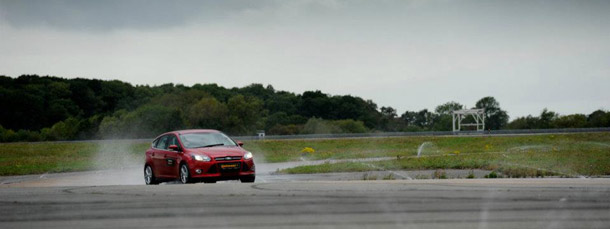A tires a tire...
Most people who fit budget tires do so based on price, why spend £300 on a set of 4 premium tires when you can spend £150 on a set of budget tires? To anyone outside the tire industry, a tire can be just a black, round thing that holds your car of the road, but with premium brand manufacturers spending hundreds of millions of pounds each year on tire research and development, budget and premium tires have vastly different properties.What does it mean in the real world?

To highlight the issue, Continental recently invited us to MIRA to drive two identical Ford Focus vehicles wearing the same size tires, with the same tread depth and the same tire pressures. The only difference? One vehicle was fitted with the multiple award winning Continental Premium Contact 2, and the other a budget tire called "Triangle CNNT GLS".
The wet handling area comprised of a windy track section which demonstrated how the tires react to high speed direction change, emergency braking and how well balanced the vehicle is. A second test, driven around a constant radius circle designed to simulate a large British roundabout in typical British weather (rain!) allowed us to measure corning speeds and how the car reacted to steering inputs at the limit of grip.
The first test comprised of the Continental Premium Contact 2 on the handling circuit. As you would expect from a wet surface, the traction wasn't as high as it is in the dry, but the car felt like it had plenty of grip, reacting well to our steering and throttle inputs. During the emergence braking the car peaked at 0.82g, and peaked at a similar 0.77G laterally in the corners.
Next up, the constant radius circle, with the Contis providing an average "on the limit grip" speed of 35mph, but offering plenty of feedback as the limit was reached, and subsequently passed. Once passed the limit of grip, the tires let you know with plenty of feedback and understeer, and while understeer is a dull handling quality, it is is also a very safe quality. Average G on the low grip circle, 0.32g.
"Immediately the difference was obvious. The car had much less grip, extremely vague steering and you had very little feedback as to whether the tire was gripping or sliding."
The Budget Tire
The Budget Tire
Next up was the turn of the budget Triangle on the wet handling circuit. Immediately the difference was obvious. The car had much less grip, extremely vague steering and you had very little feedback as to whether the tire was gripping or sliding. Power understeer, something barely noticed with the premium tire was much more of an issue, with the grip disappearing quickly and taking a long time to regain control once the tire started sliding. The constantly circle proved even more worrying, with the car seemingly switching between understeer and oversteer with very little steering feel or input. Peak Gs? A meer 0.61G under braking and just 0.55G laterally, some 30% less than the premium tire.
We get a lot of questions asking whether budget tires are worth the saving, and we can now say with certianty they are not. Its not just the lack of raw grip, it's how the car reacts at the limit, and how much control you have once past the limit. A well developed premium tire has been tested in all situations, where a budget tire is an unknown quantity.
Further Reading:







